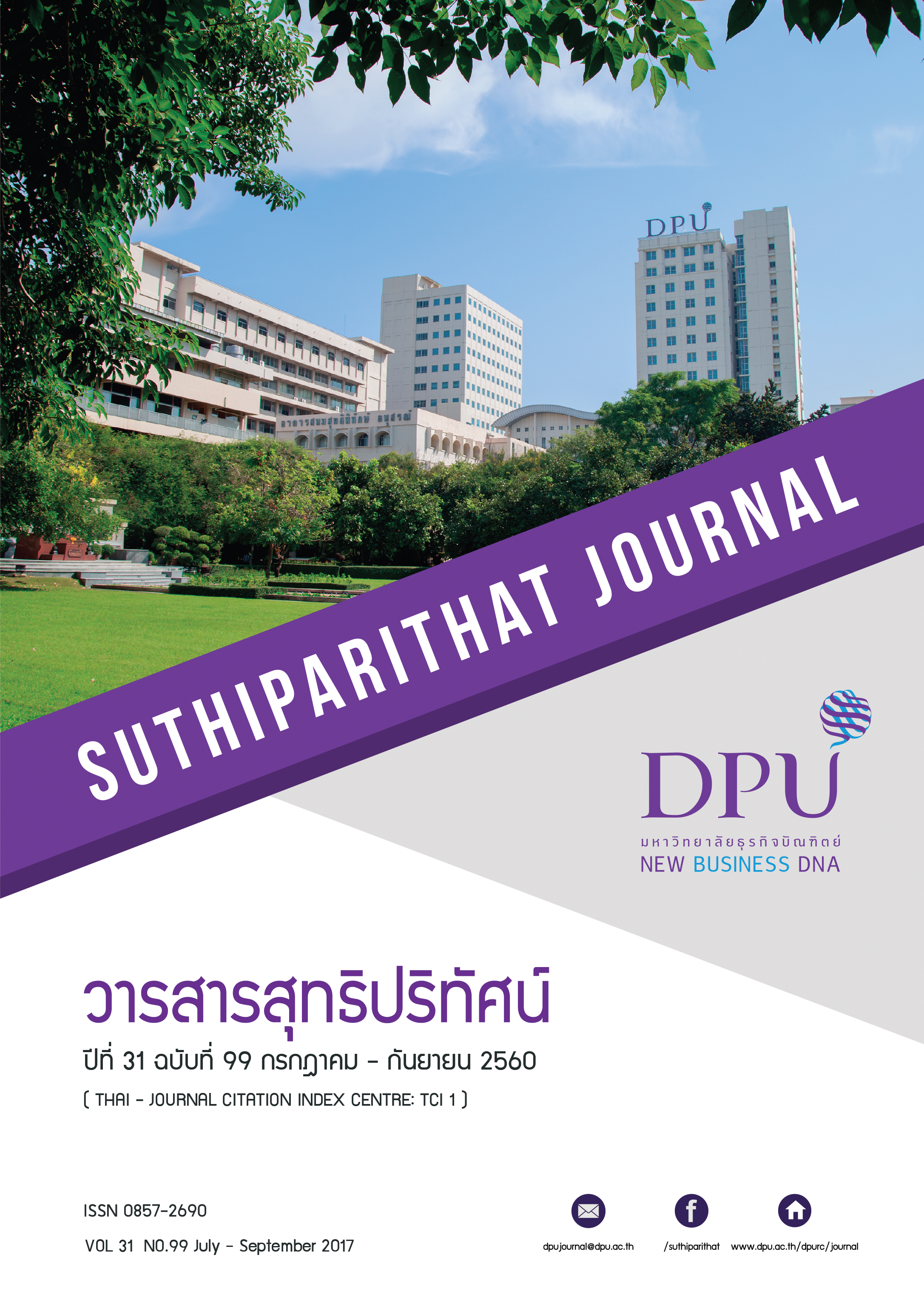ความสัมพันธ์ระหว่างประสบการณ์เดินทางท่องเที่ยวกับความพึงพอใจของนักท่องเที่ยว: กรณีศึกษานักท่องเที่ยว ชาวเอเชียที่เดินทางมาท่องเที่ยวจังหวัดภูเก็ต
คำสำคัญ:
ประสบการณ์ท่องเที่ยว, ความพึงพอใจ, นักท่องเที่ยวชาวเอเชีย, ภูเก็ต, ประเทศไทยบทคัดย่อ
ตลาดนักท่องเที่ยวชาวเอเชียเป็นตลาดที่สำคัญตลาดหนึ่งของอุตสาหกรรมการท่องเที่ยวของ จังหวัดภูเก็ต เนื่องจากจำนวนนักท่องเที่ยวชาวเอเชียที่เพิ่มมากขึ้นและการกลับมาเที่ยวซ้ำ ของนักท่องเที่ยวกลุ่มนี้ อย่างไรก็ตาม ยังมีงานวิจัยไม่มากนักที่ศึกษาตลาดนักท่องเที่ยวชาวเอเชียในแง่ของประสบการณ์ ท่องเที่ยวและความพึงพอใจของนักท่องเที่ยวในการมาเยือนจังหวัดภูเก็ต การเข้าใจถึงความสัมพันธ์ระหว่างสองตัวแปรดังกล่าวจะช่วยให้หน่วยงานท้องถิ่นที่เกี่ยวข้องสามารถพัฒนากลยุทธ์การท่องเที่ยว ได้อย่างเหมาะสมเพื่อดึงดูดกลุ่มเป้าหมาย ดังนั้น งานวิจัยในครั้งนี้จึงมีวัตถุประสงค์การวิจัยเพื่อศึกษา อิทธิพลของประสบการณ์ท่องเที่ยวที่มีต่อความพึงพอใจของนักท่องเที่ยวในการมาเยือนจังหวัดภูเก็ต โดยเก็บรวบรวมข้อมูลจากนักท่องเที่ยวชาวเอเชียจำนวน 232 คน โดยใช้การเลือกตัวอย่างแบบตามสะดวก และวิเคราะห์ข้อมูลโดยการวิเคราะห์การถดถอยพหุคูณ (multiple regression analysis) ผลการวิจัยพบว่า ประสบการณ์เดินทางท่องเที่ยวมีอิทธิพลทางบวกต่อความพึงพอใจของนักท่องเที่ยว โดยเฉพาะอย่างยิ่ง ประสบการณ์ท่องเที่ยวในด้านชายทะเล อัธยาศัยไมตรีของคนในท้องถิ่น และความคุ้มค่าของจุดหมาย ปลายทางการท่องเที่ยว มีอิทธิพลต่อความพึงพอใจของนักท่องเที่ยวอย่างมีนัยสำคัญทางสถิติ งานวิจัย ในครั้งนี้จึงได้ให้ข้อเสนอแนะเพื่อส่งเสริมการท่องเที่ยวของจังหวัดภูเก็ต
เอกสารอ้างอิง
Alexandris, K., Kouthouris, C., & Meligdis, A. (2006). Increasing customers’ loyalty in a skiing resort. International Journal of Contemporary Hospitality Management, 18(5), 414-425.
Caru, A., & Cova, B. (2007). Consuming experiences: An introduction. London: Routledge.
Chi, C. & Qu, H. (2008). Examining the structural relationships of destination image, tourists, satisfaction and destination loyalty: An integrated approach. Tourism Management, 29, 624-636.
Ekiz, E. & Khoo-Lattimore, C. (2014). Destination India: investigating the impact of Goa’s attributes on families’ leisure travel experience. TOURISM, 62(2), 165-180.
Hair, J., Anderson, R., Tatham, R., & Black, W. (2006). Multivariate Data Analysis. 6thed. LA: Prentice-Hall International.
Heung, V. & Cheng, E. (2000). Assessing tourists’ satisfaction with shopping in the Hong Kong special administrative region of China. Journal of Travel Research, 38, 396-404.
Hsu, C. (2003). Mature motor-coach travelers’ satisfaction: A preliminary step toward measurement development. Journal of Hospitality and Tourism Research, 20(10), 1-19.
Kaiser, H. (1974). An index of factorial simplicity. Psychologist, 39(2), 31-36.
Kim, A. & Brown, G. (2012). Understanding the relationships between perceived travel experiences, overall satisfaction, and destination loyalty. Anatolia – An International Journal of Tourism and Hospitality Research, 23(3), 328-347.
Kozak, M. & Rimmington, M. (2000). Tourist satisfaction with Mallorca, Spain, as an off-season holiday destination. Journal of Travel Research, 38, 260-269.
Kozak, M., Bigne, E., & Andreu, L. (2004). Satisfaction and destination loyalty: A comparison between non-repeat and repeat tourists. Journal of Quality Insurance in Hospitality and Tourism, 5(1), 43-59.
Marzuki, A. (2012). Local residents’ perceptions towards economic impacts of tourism development in Phuket. TOURISM, 60(2), 199-212.
McDowall, S. & Ma, E. (2010). An Analysis of tourists’ evaluation of Bangkok’s performance, their satisfaction, and destination loyalty: Comparing international versus domestic Thai tourists. Journal of Quality Assurance in Hospitality & Tourism, 11(4), 260-282.
Mechinda, P., Serirat, S., & Gulid, N. (2009). An examination of tourists’ attitudinal and behavioral loyalty: Comparison between domestic and international tourists. Journal of Vacation Marketing, 15(2), 129-148.
Mohamad, M. & Ghani, N. (2014). The impact of tourist satisfaction on destination loyalty among European tourists visiting Malaysia. International Journal of Management Sciences. 2(8), 362-371.
Panitcharemkit, D. (2013). Local creative tourism: A case study on Phuket. Journal of US-China Public Administration, 10(3), 303-309.
Polnyotee, M. & Thadaniti, S. (2014). The survey of factors influencing sustainable tourism at Patong beach, Phuket island, Thailand. Mediterranean Journal of Social Sciences, 5(9), 650-655.
Reisinger, Y. & Turner, L. W. (2003). Cross-cultural behavior in tourism: Concepts and analysis. Oxford: Butterworth-Heinermann.
The Government Public Relations Departmemt. (2015). Chiang Mai, Bangkok, and Phuket voted among most popular destinations in Asia. Retrieved 1 July 2016, from http://thailand.prd.go.th/ewt_news.phpnid=2414&filename=index.
Thongkundam, P. & Promsivapallop, P. (2012). Australian and Russian tourists’ perception of Phuket’s destination image. Conference proccedding of the first Annual PSU Phuket International Conference. 10 January 2013. Prince of Songkla University, Phuket campus.
Tourism Authority of Thailand. (2015). Tourism statistics. Retrieved 15 October 2016, from http://www2.tat.or.th/stat/web/static_download.php?Rpt=ats
Sangpikul, A. (2008). Travel motivations and tourist behaviors of Korean travelers (research report). Bangkok: Dhurakij Pundit University.
Williams, T., Sweeney, D., & Anderson, D. (2006). Contemporary Business Statistics. LA: Thomson South-Western.
Yoon, Y. & Uysal, M. (2005). An examination of the effects of motivational and satisfaction on destination loyalty: A structural model. Tourism Management, 26, 4
ดาวน์โหลด
เผยแพร่แล้ว
รูปแบบการอ้างอิง
ฉบับ
ประเภทบทความ
สัญญาอนุญาต
เนื้อหาและข้อมูลในบทความที่ลงตีพิมพ์ในวารสารสุทธิปริทัศน์ ถือเป็นข้อคิดเห็นและความรับผิดชอบของผู้เขียนบทความโดยตรงซึ่งกองบรรณาธิการวารสาร ไม่จำเป็นต้องเห็นด้วย หรือร่วมรับผิดชอบใด ๆ
บทความ ข้อมูล เนื้อหา รูปภาพ ฯลฯ ที่ได้รับการตีพิมพ์ในวารสารสุทธิปริทัศน์ ถือเป็นลิขสิทธิ์ของวารสารสุทธิปริทัศน์หากบุคคลหรือหน่วยงานใดต้องการนำทั้งหมดหรือส่วนหนึ่งส่วนใดไปเผยแพร่ต่อหรือเพื่อกระทำการใด ๆ จะต้องได้รับอนุญาตเป็นลายลักษณ์อักษรจากวารสารสุทธิปริทัศน์ก่อนเท่านั้น







